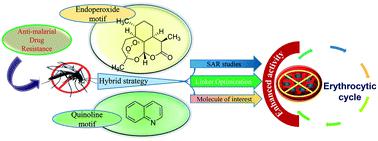当前位置:
X-MOL 学术
›
RSC Med. Chem.
›
论文详情
Our official English website, www.x-mol.net, welcomes your feedback! (Note: you will need to create a separate account there.)
Medicinal chemistry updates on quinoline- and endoperoxide-based hybrids with potent antimalarial activity
RSC Medicinal Chemistry ( IF 4.1 ) Pub Date : 2020-11-7 , DOI: 10.1039/d0md00244e Amad Uddin 1, 2 , Meenal Chawla 1 , Iram Irfan 1 , Shubhra Mahajan 1 , Shailja Singh 2 , Mohammad Abid 1
RSC Medicinal Chemistry ( IF 4.1 ) Pub Date : 2020-11-7 , DOI: 10.1039/d0md00244e Amad Uddin 1, 2 , Meenal Chawla 1 , Iram Irfan 1 , Shubhra Mahajan 1 , Shailja Singh 2 , Mohammad Abid 1
Affiliation

|
The resistance of conventional antimalarial drugs against the malarial parasite continues to pose a challenge to control the disease. The indiscriminate exploitation of the available antimalarials has resulted in increasing treatment failures, which urges on the search for novel lead molecules. Artemisinin-based combination therapy (ACT) is the current WHO-recommended first-line treatment for the majority of malaria cases. Hybrid molecules offer a newer strategy for the development of next-generation antimalarial drugs. These comprise molecules, each with an individual pharmacological activity, linked together into a single hybrid molecule. This approach has been utilized by several research groups to develop molecules with potent antimalarial activity. In this review, we provide an overview of the pivotal roles of quinoline- and endoperoxide-based hybrids as inhibitors of the life-cycle progression of Plasmodium. Based on the exhaustive literature reports, we have collated the structural and functional analyses of quinoline- and endoperoxide-based hybrid molecules that show potency equal to or greater than those of the individual compounds, offering an effective therapeutics option for clinical use.
中文翻译:

具有有效抗疟活性的喹啉和内过氧化物杂化物的药物化学更新
传统抗疟药物对疟原虫的耐药性继续对控制这种疾病构成挑战。对可用抗疟药的不加区分的开发导致了治疗失败的增加,这促使人们寻找新的先导分子。基于青蒿素的联合疗法 (ACT) 是目前世卫组织推荐的用于大多数疟疾病例的一线治疗方法。杂交分子为开发下一代抗疟药物提供了一种新的策略。这些包括分子,每个分子都具有单独的药理活性,连接在一起形成一个单一的杂化分子。几个研究小组已经利用这种方法来开发具有有效抗疟活性的分子。在这次审查中,疟原虫。基于详尽的文献报告,我们整理了基于喹啉和内过氧化物的杂化分子的结构和功能分析,这些分子显示出等于或大于单个化合物的效力,为临床使用提供了有效的治疗选择。
更新日期:2021-01-12
中文翻译:

具有有效抗疟活性的喹啉和内过氧化物杂化物的药物化学更新
传统抗疟药物对疟原虫的耐药性继续对控制这种疾病构成挑战。对可用抗疟药的不加区分的开发导致了治疗失败的增加,这促使人们寻找新的先导分子。基于青蒿素的联合疗法 (ACT) 是目前世卫组织推荐的用于大多数疟疾病例的一线治疗方法。杂交分子为开发下一代抗疟药物提供了一种新的策略。这些包括分子,每个分子都具有单独的药理活性,连接在一起形成一个单一的杂化分子。几个研究小组已经利用这种方法来开发具有有效抗疟活性的分子。在这次审查中,疟原虫。基于详尽的文献报告,我们整理了基于喹啉和内过氧化物的杂化分子的结构和功能分析,这些分子显示出等于或大于单个化合物的效力,为临床使用提供了有效的治疗选择。



























 京公网安备 11010802027423号
京公网安备 11010802027423号